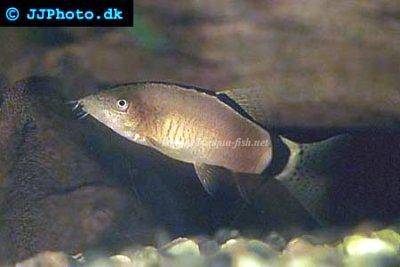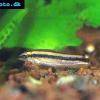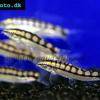Skunk botia - Yasuhikotakia morleti
Scientific name: Yasuhikotakia morleti
Common name: Skunk botia
Family: Botiidae
Usual size in fish tanks: 8 - 10 cm (3.15 - 3.94 inch)
014
Recommended pH range: 6.4 - 7.8
Recommended water hardness: 5 - 12°N (89.29 - 214.29ppm)
0°C 32°F30°C 86°F
Recommended temperature range: 24 - 29 °C (75.2 - 84.2°F)
The way how these fish reproduce: Spawning
Where the species comes from: Southeast Asia
Temperament to its own species: peaceful
Temperament toward other fish species: peaceful
Usual place in the tank: Bottom levels
General Information
Skunk Botia (Yasuhikotakia morleti, syn. Botia morleti) is a robust, high-energy loach from Southeast Asia, occurring in lowland rivers and floodplain channels of Thailand, Laos, Cambodia and adjacent regions. Adults commonly reach 8–10 cm TL in aquaria. Despite the small size, this is a pugnacious, hierarchical species: keep it in a group of 5–8 to diffuse aggression; pairs/trios tend to bully relentlessly. Expect crepuscular/nocturnal activity and frequent sand-burrowing.
Food & Feeding
An opportunistic carnivore with some omnivory. Provide sinking carnivore pellets as a staple and rotate frozen/live foods (bloodworms, blackworms, brine shrimp, daphnia). They gladly consume snails and will decimate populations. Offer small vegetable items (blanched spinach, spirulina wafers) occasionally for balance. Feed at lights-out or under dim light so subdominant fish get their share; remove uneaten food to protect water quality.
Sexing
External sexing is unreliable on juveniles. Females are typically fuller-bodied when mature; males may appear slightly slimmer. Both sexes possess suborbital spines used in disputes—handle with care.
Breeding
Natural spawning in home aquaria is undocumented/exceptional. Commercial production is believed to rely on hormonal induction. If you observe courtship or eggs, document conditions thoroughly.
Lifespan
With good care and low stress, expect roughly 8–10 years (longer is possible); the commonly quoted “6 years” is conservative.
Tank Requirements & Water Parameters
- Group & footprint: house in groups (5–8 ). Provide a tank length of 90–120 cm (36–48″) with ample floor area and many hiding spots.
- Substrate: soft sand (preferred) or smooth fine gravel; they burrow and can abrade barbels on sharp gravel.
- Décor: caves, tubes, rock piles, dense woodwork; ensure structures are rock-solid—this species digs.
- Flow & oxygen: moderate current with strong aeration/filtration; they appreciate clean, well-oxygenated water.
- Temperature: 24–29 °C (75–84 °F); pH: ~6.4–7.8; hardness: soft to moderate (~5–12 °dH).
- Maintenance: weekly water changes (25–35 %) and stable parameters; avoid sudden swings.
Compatibility & Tank Mates
Semi-aggressive. Best with fast, robust midwater species of comparable size (barbs, larger rasboras, many danionins) and sturdy catfish/plecos. Avoid very small fish, slow long-finned species, timid bottom dwellers, shrimp, and delicate snails (they’ll be eaten). Keeping a proper group size and providing line-of-sight breaks greatly reduces harassment.
Behaviour & Usual Place in the Tank
Primarily a bottom-level fish; rests under décor by day and patrols at dusk/night. Displays classic loach “clicking” during social interactions, chasing, and feeding. Expect intra-group sparring to set rank—this is normal if space and hides are ample.
Health Notes
- Ich sensitivity: like many loaches, susceptible to Ich and to harsh medications—use heat/oxygenation and loach-safe doses.
- New tank caution: introduce only to mature, stable aquaria; they are intolerant of ammonia/nitrite and chronically high nitrate.
Short Description
Yasuhikotakia morleti is a compact but punchy loach from Southeast Asia. Keep a sizable group in a well-covered, well-filtered tank with soft sand and many caves. Provide meaty sinking foods, expect snail control, and manage its feisty nature with numbers, space, and structure.
Pictures
Bought by aqua-fish.net from jjphoto.dk. Also thank to Jonathon Whipple.



 Black-lined
Black-lined  Dwarf
Dwarf